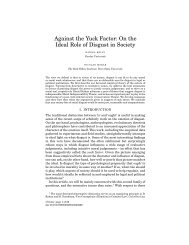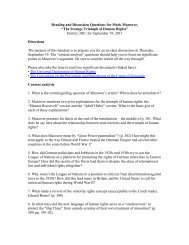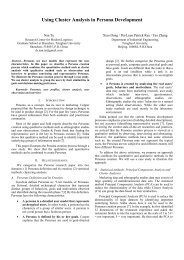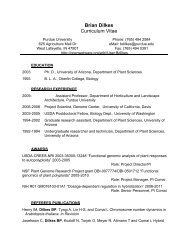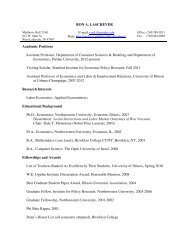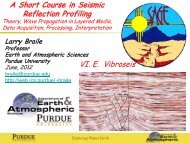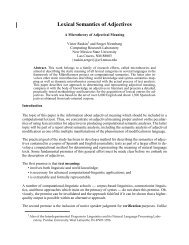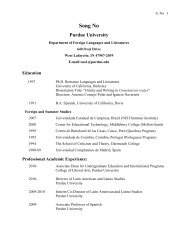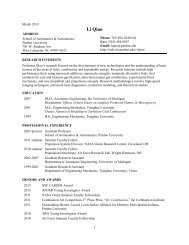The Dopamine Hypothesis of Schizophrenia: An Historical and ...
The Dopamine Hypothesis of Schizophrenia: An Historical and ...
The Dopamine Hypothesis of Schizophrenia: An Historical and ...
Create successful ePaper yourself
Turn your PDF publications into a flip-book with our unique Google optimized e-Paper software.
56 ■ PPP / Vol. 18, No. 1 / March 2011<br />
probability <strong>of</strong> being true, this probability has<br />
declined over the years as non-verifications have<br />
substantially outnumbered verifications. However,<br />
it is possible that further advances in genetics or<br />
imaging that confirm predictions <strong>of</strong> the DHS could<br />
reverse this trend.<br />
<strong>The</strong> Bayesian viewpoint—one strength <strong>of</strong><br />
which is its ability to be consistently updated as<br />
new information becomes available—can also<br />
incorporate evolution <strong>of</strong> the theory itself. That<br />
is, we could see the “revised” DHS articulated by<br />
Davis et al. (Figure 2) as a new theory that might<br />
have stronger support from a Bayesian viewpoint.<br />
Other Accounts <strong>of</strong> Scientific Progress<br />
<strong>and</strong> the Issues <strong>of</strong> <strong>The</strong>ory Identity <strong>and</strong><br />
<strong>The</strong>ory Substructure<br />
Other philosophers <strong>of</strong> science have grappled<br />
with the issues <strong>of</strong> scientific progress, including<br />
Laudan (1977), Shapere <strong>and</strong> Dordrecht (1984),<br />
<strong>and</strong> Kitcher (1993). <strong>The</strong>se philosophers have additional<br />
suggestions that, although possibly useful<br />
for the DHS, cannot be reviewed in the space<br />
available. It might be <strong>of</strong> interest, however, to note<br />
yet another problem for the DHS that would be<br />
raised by Laudan’s analysis.<br />
In his Progress <strong>and</strong> Its Problems, Laudan set<br />
out a problem-solving model <strong>of</strong> progress in which<br />
quite disparate “research traditions” could compete<br />
with each other by attempting to solve their<br />
own key problems more efficiently <strong>and</strong> completely.<br />
Applying this commonsensical approach to the<br />
evaluation <strong>of</strong> scientific progress, we can simply<br />
ask—Did the DHS achieve its main aim <strong>of</strong> solving<br />
the problem <strong>of</strong> the etiology <strong>of</strong> schizophrenia? <strong>The</strong><br />
answer, we would suggest, is no. However, we are<br />
aware that this is a high st<strong>and</strong>ard especially for<br />
the young field <strong>of</strong> psychiatry.<br />
<strong>The</strong> history <strong>of</strong> DHS’s attempted verifications<br />
<strong>and</strong> apparent falsifications reviewed above highlights<br />
the changing character <strong>of</strong> the assumptions<br />
<strong>of</strong> the DHS over time. This is a feature <strong>of</strong> what<br />
Kuhn termed paradigms <strong>and</strong> Lakatos referred<br />
to as research programs, <strong>and</strong> an adaptation <strong>and</strong><br />
elaboration <strong>of</strong> Lakatos’ distinction between the<br />
hard core <strong>and</strong> the peripheral hypotheses <strong>of</strong> a<br />
theory might shed some additional light on this<br />
history. One <strong>of</strong> us (KFS) has developed a relevant<br />
philosophical account <strong>of</strong> scientific progress that<br />
incorporates these themes from both Kuhn <strong>and</strong><br />
Lakatos (Schaffner 1993), the elements <strong>of</strong> which<br />
were introduced above <strong>and</strong> represented graphically<br />
in an atemporal manner in Figures 1 <strong>and</strong> 2<br />
(that is, we are not showing temporal progression<br />
<strong>of</strong> the changing theories over time, but only the<br />
alternatives at a given time).<br />
That analysis, extensively applied to a research<br />
program in immunology in (Schaffner 1992), suggests<br />
that a research program is best analyzed as<br />
a temporally extended theory (TET), which is in<br />
turn partitioned into high-level central hypotheses<br />
<strong>and</strong> a temporal series <strong>of</strong> more specific mechanisms<br />
that embody the central hypothesis. If the specific<br />
mechanisms, which instantiate the central high<br />
level hypothesis <strong>and</strong> are empirically testable, fail<br />
tests <strong>of</strong> verification, <strong>and</strong> these mechanisms become<br />
patched up in ad hoc ways, then any competing<br />
account with a distinctly different central<br />
high-level hypothesis becomes significantly more<br />
attractive. On the other h<strong>and</strong>, if a TET is successful,<br />
investigators working with it will develop a<br />
series <strong>of</strong> rigorous experimental tests that cannot<br />
be accounted for by other competing mechanisms.<br />
When that situation occurs, the TET account suggests<br />
that we have attained “direct evidence” for<br />
the high-level central hypothesis. Viewed from<br />
this perspective, the DHS would have the central<br />
high-level hypothesis <strong>of</strong> excess DA activity contributing<br />
to the etiology <strong>of</strong> schizophrenia. <strong>The</strong><br />
specific mechanisms (<strong>and</strong> their related tests <strong>of</strong><br />
CSF, endocrine measures, post-mortem DA levels)<br />
have generally faired poorly in empirical tests <strong>and</strong><br />
thereby reflected poorly on the attractiveness <strong>of</strong><br />
the central hypothesis. <strong>The</strong> search for such “direct<br />
evidence” was a “holy grail” <strong>of</strong> DHS research,<br />
<strong>and</strong>, alas, like the grail, it has not yet been found.<br />
This TET analysis also suggests that only by<br />
stretching the original central or core abstract<br />
hypothesis was the theory significantly modified<br />
as in Davis et al.’s 1991 revised DHS. It is possible<br />
that the central or core hypothesis could be<br />
still further abstracted from the original DHS<br />
formulation, namely to the even more unspecific<br />
claim that “dopamine must have something to do<br />
with schizophrenia” or the problem is with DA<br />
“dysregulation.” However, such an additional



